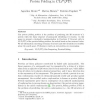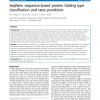152 search results - page 1 / 31 » Using Secondary Structure Information for Protein Folding in... |
ENTCS
2002
13 years 4 months ago
2002
JUCS
2010
13 years 3 months ago
2010
: When considering the prediction of a structural class for a protein as a classification problem, usually a classifier is based on a feature vector x ∈ Rn , where the features...
ICASSP
2007
IEEE
13 years 11 months ago
2007
IEEE
Protein structure prediction aims to determine the three-dimensional structure of proteins form their amino acid sequences. When a protein does not have similarity (homology) to a...
BMCBI
2010
13 years 5 months ago
2010
Background: Protein folding rate is an important property of a protein. Predicting protein folding rate is useful for understanding protein folding process and guiding protein des...
BMCBI
2008
13 years 5 months ago
2008
Background: Residue depth allows determining how deeply a given residue is buried, in contrast to the solvent accessibility that differentiates between buried and solvent-exposed ...


